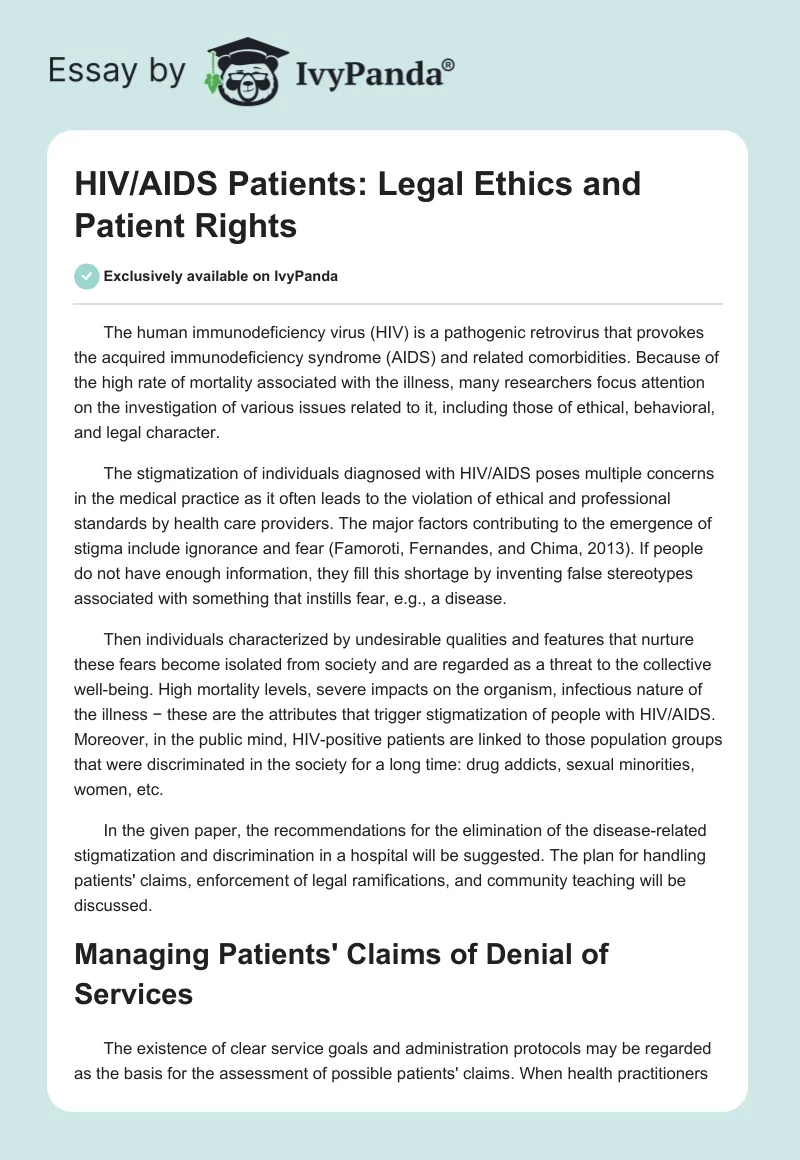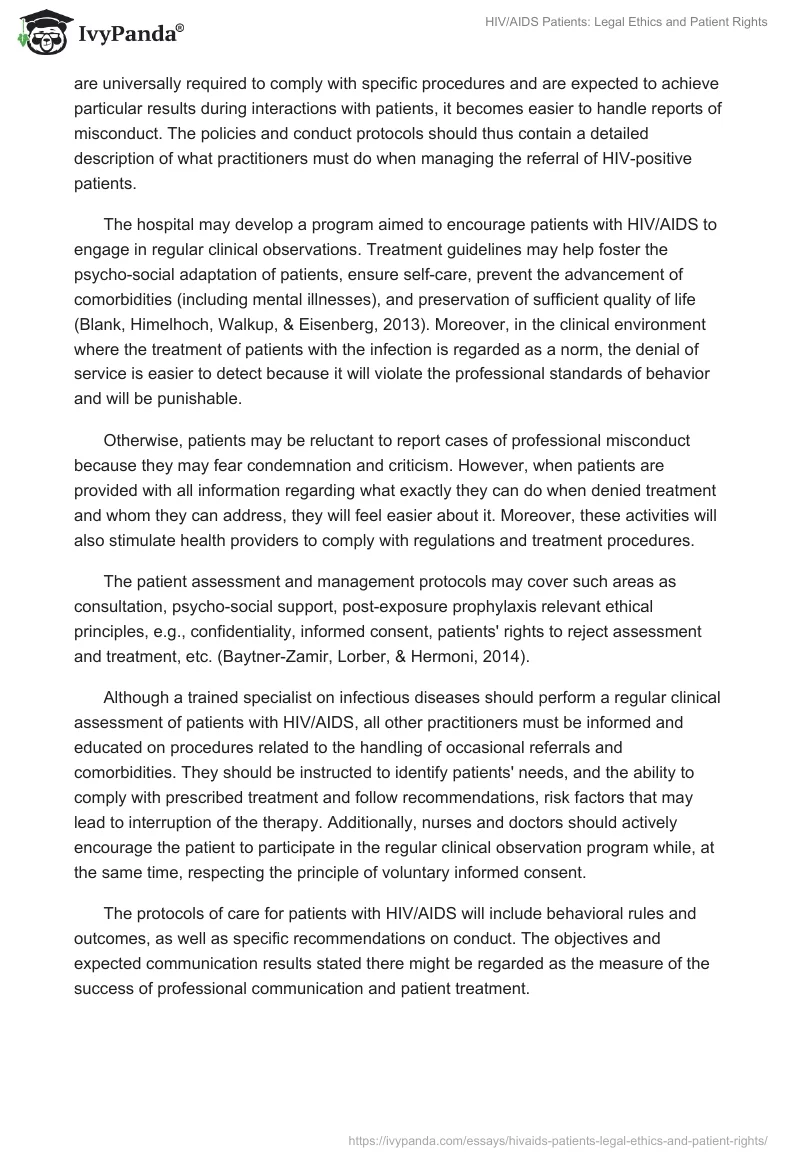The human immunodeficiency virus (HIV) is a pathogenic retrovirus that provokes the acquired immunodeficiency syndrome (AIDS) and related comorbidities. Because of the high rate of mortality associated with the illness, many researchers focus attention on the investigation of various issues related to it, including those of ethical, behavioral, and legal character.
The stigmatization of individuals diagnosed with HIV/AIDS poses multiple concerns in the medical practice as it often leads to the violation of ethical and professional standards by health care providers. The major factors contributing to the emergence of stigma include ignorance and fear (Famoroti, Fernandes, and Chima, 2013). If people do not have enough information, they fill this shortage by inventing false stereotypes associated with something that instills fear, e.g., a disease.
Then individuals characterized by undesirable qualities and features that nurture these fears become isolated from society and are regarded as a threat to the collective well-being. High mortality levels, severe impacts on the organism, infectious nature of the illness − these are the attributes that trigger stigmatization of people with HIV/AIDS. Moreover, in the public mind, HIV-positive patients are linked to those population groups that were discriminated in the society for a long time: drug addicts, sexual minorities, women, etc.
In the given paper, the recommendations for the elimination of the disease-related stigmatization and discrimination in a hospital will be suggested. The plan for handling patients’ claims, enforcement of legal ramifications, and community teaching will be discussed.
Managing Patients’ Claims of Denial of Services
The existence of clear service goals and administration protocols may be regarded as the basis for the assessment of possible patients’ claims. When health practitioners are universally required to comply with specific procedures and are expected to achieve particular results during interactions with patients, it becomes easier to handle reports of misconduct. The policies and conduct protocols should thus contain a detailed description of what practitioners must do when managing the referral of HIV-positive patients.
The hospital may develop a program aimed to encourage patients with HIV/AIDS to engage in regular clinical observations. Treatment guidelines may help foster the psycho-social adaptation of patients, ensure self-care, prevent the advancement of comorbidities (including mental illnesses), and preservation of sufficient quality of life (Blank, Himelhoch, Walkup, & Eisenberg, 2013). Moreover, in the clinical environment where the treatment of patients with the infection is regarded as a norm, the denial of service is easier to detect because it will violate the professional standards of behavior and will be punishable.
Otherwise, patients may be reluctant to report cases of professional misconduct because they may fear condemnation and criticism. However, when patients are provided with all information regarding what exactly they can do when denied treatment and whom they can address, they will feel easier about it. Moreover, these activities will also stimulate health providers to comply with regulations and treatment procedures.
The patient assessment and management protocols may cover such areas as consultation, psycho-social support, post-exposure prophylaxis relevant ethical principles, e.g., confidentiality, informed consent, patients’ rights to reject assessment and treatment, etc. (Baytner-Zamir, Lorber, & Hermoni, 2014).
Although a trained specialist on infectious diseases should perform a regular clinical assessment of patients with HIV/AIDS, all other practitioners must be informed and educated on procedures related to the handling of occasional referrals and comorbidities. They should be instructed to identify patients’ needs, and the ability to comply with prescribed treatment and follow recommendations, risk factors that may lead to interruption of the therapy. Additionally, nurses and doctors should actively encourage the patient to participate in the regular clinical observation program while, at the same time, respecting the principle of voluntary informed consent.
The protocols of care for patients with HIV/AIDS will include behavioral rules and outcomes, as well as specific recommendations on conduct. The objectives and expected communication results stated there might be regarded as the measure of the success of professional communication and patient treatment.
Health Providers’ Roles
The development of appropriate ethical culture within the setting may be considered the primary way in which different staffing levels can contribute to upholding ethical conduct. HIV/AIDS phobia is a social-psychological phenomenon which represents an inevitable reaction of the majority of people on the given disease. Individuals may fear contamination, imminent death, the feebleness of the medicine to cope with the given condition, etc. Subconsciously, when facing the disease, people will try to avoid thinking about it or will stigmatize those who have it. Unfortunately, the given behavior is widespread among health providers as well.
As stated by Famoroti et al. (2013), the core reasons for negative attitudes of health practitioners towards HIV-positive patients and unethical conduct include fear of contagion and the lack of knowledge about appropriate methods for maintaining patient confidentiality. The given behavioral and attitudinal factors largely contribute to practitioners’ refusal to provide care for patients with HIV/AIDS. Since the core of the problem lies in the sphere of knowledge and individual behavior, the creation of appropriate corporate culture that would support the development of care providers’ competence and awareness can help to fight the stigmatization of HIV-positive individuals within the hospital.
Leaders, managers, and supervisors will play a major role in the development of such a culture. At the same time, the main responsibilities of nurses and doctors will be the implementation of values embedded in it. A well-developed ethical culture may provide an excellent supporting background for practitioners to withstand the existing myths and prejudices related to HIV/AIDS, maintain an objective view on the disease, and in this way, both respect the dignity of patients and prevent the dissemination of the infection in the community.
Enforcement of Legal Ramifications
Health care providers’ ethical misconduct may have severe legal consequences. According to the World Medical Association (WMA, 2006), “all persons infected or affected by HIV/AIDS are entitled to adequate prevention, support, treatment and care with compassion and respect for human dignity” (par. 1). Moreover, it is stated that “a physician may not ethically refuse to treat a patient whose condition is within his or her current realm of competence, solely because the patient is seropositive” (WMA, 2006, par. 1). The rights of HIV-positive patients are also protected by domestic law, and when the practitioner discriminates them, he/she acts illegally.
In this case, the patient may defend his/her rights for treatment in the court, and the doctor or the hospital may be held responsible for professional incompetence and unfair treatment of patients. To avoid this, health practitioners should be provided with instructions by following which they will be able to undertake all protection measures and perform all required ethical standards. Additionally, when the health problem of an HIV-positive patient is beyond the scope of the practitioner’s performance, he/she should refer this individual to a specialist who has everything needed to intervene in the adverse condition. Until the patient is transferred to a specialized medical institution, the doctor must do everything in his power to assist him/her.
To ensure compliance with legal requirements and reduce the risk of engagement in disputes with patients, the hospital’s management can design an appropriate reinforcement and motivation system. To do so, the organizational policies must outline the behavioral goals that would be rewarded and recognized and, reversely, those which may be associated with punishments and fines. The desirable behaviors may include the implementation of basic ethical standards such as confidentiality, voluntary informed consent, and so on.
Community Relations Plan
The concept of stigma can be viewed in two ways − as a phenomenon associated with acts of discrimination, and as a sense of shame developed in HIV-positive individuals and the fear of condemnation. Both sides of the issue negatively impact patients with HIV/AIDS and may interfere with their ability to resist infection because stigmatization exacerbates stress. Depression, despair, and bitterness are the common consequences of such adverse experiences. According to Bitew et al. (2016), the likelihood of suicide in the HIV-infected population is 7-36 times higher than in non-infected people. Additionally, it is observed that a high prevalence of depression in patients with HIV/AIDS poses one of the biggest barriers to adhering to antiretroviral therapy (Betancur, Lins, Oliveira, & Brites, 2017).
Thus, it leads to a rapid deterioration of patients’ conditions. Research findings obtained by Bhatia and Munjal (2014) reveal that women, unemployed individuals, and patients from lower-income groups are associated with a higher prevalence of depression than those who have sources of social and family support. Therefore, it can be recommended to address the issues of population vulnerability in the hospital’s community relations program. The plan should be oriented to both the prevention of discrimination of those already infected and the promotion of responsible behavior in vulnerable populations, i.e., adolescents, women, homosexual men, etc.
The hospital may develop partnerships with local schools to educate students. Menna, Ali, and Worku (2015) state that the level of knowledge about HIV/AIDS issues among adolescents remains low and many young people are prone to be engaged in risky sexual behaviors due to a lack of awareness of risks associated with them. Youth is usually aware of AIDS prevention procedures, but a lot of young people still do not implement health-protective practices. Thus, it is important to address both the practical and theoretical aspects of HIV prevention throughout the community teaching program.
It can also be recommended to collaborate with social organizations to support vulnerable HIV-positive patients. Nurses and trained volunteers may provide psychological counseling and practical assistance to patients and their families. Additionally, the hospital may participate in the design of social campaigns aimed to increase public awareness regarding broad factors associated with vulnerable population groups, including poverty, sexual exploitation of women, lack of education, social isolation, etc. The strategy should consider the gender aspect of epidemics and describe the methods which may help in reducing the vulnerability of the identified demographic groups.
Conclusion
HIV/AIDS-related stigma interferes with the provision of high-quality care for affected individuals and inhibits the creation and realization of AIDS prevention programs. Since discrimination is linked to power relationships, hospitals should use their authority to dispel the existing stereotypes which reduce patients’ access to care. In case the health care provider stigmatizes HIV-positive patients, he/she may contribute to the deterioration of their condition at both individual and social levels. Therefore, the proposed plans aimed at the development of appropriate hospital culture, the design of practical guidelines, and the enforcement of ethical standards through the efficient motivation system may help eliminate health disparities and ensure fair treatment of all individuals regardless of their HIV status.
References
Baytner-Zamir, R., Lorber, M., & Hermoni, D. (2014). Assessment of the knowledge and attitudes regarding HIV/AIDS among pre-clinical medical students in Israel. BMC Research Notes, 7, 168. Web.
Betancur, M. N., Lins, L., Oliveira, I. R., & Brites, C. (2017). Quality of life, anxiety and depression in patients with HIV/AIDS who present poor adherence to antiretroviral therapy: A cross-sectional study in Salvador, Brazil. The Brazilian Journal of Infectious Diseases. Web.
Bhatia, M. S., & Munjal, S. (2014). Prevalence of depression in people living with HIV/AIDS undergoing ART and factors associated with it. Journal of Clinical and Diagnostic Research : JCDR, 8(10), WC01–WC04. Web.
Bitew, H., Andargie, G., Tadesse, A., Belete, A., Fekadu, W., & Mekonen, T. (2016). Suicidal Ideation, Attempt, and Determining Factors among HIV/AIDS Patients, Ethiopia. Depression Research and Treatment, 2016, 1-6. Web.
Blank, M. B., Himelhoch, S., Walkup, J., & Eisenberg, M. M. (2013). Treatment considerations for HIV-infected individuals with severe mental illness. Current HIV/AIDS Reports, 10(4), 10.1007/s11904–013–0179–3. Web.
Famoroti, T. O., Fernandes, L., & Chima, S. C. (2013). Stigmatization of people living with HIV/AIDS by healthcare workers at a tertiary hospital in KwaZulu-Natal, South Africa: A cross-sectional descriptive study. BMC Medical Ethics, 14(1), S6. Web.
Menna, T., Ali, A., & Worku, A. (2015). Effects of peer education intervention on HIV/AIDS related sexual behaviors of secondary school students in Addis Ababa, Ethiopia: a quasi-experimental study. Reproductive Health, 12(1), 1-8. Web.
World Medical Association. (2006). WMA statement on HIV/AIDS and the medical profession. Web.


